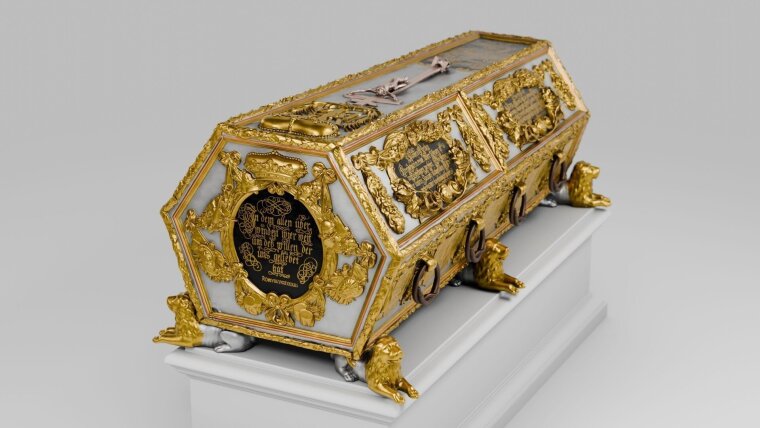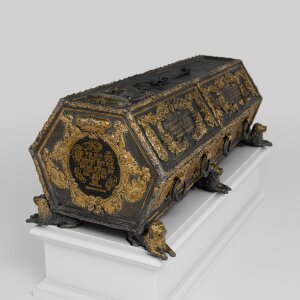
Published: | By: Sebastian Hollstein
The restored coffin as it looks today.
Image: Digitus Art/Universität JenaThe Principality of Saxe-Jena existed for just 18 years before the last male scion, Johann Wilhelm, died in 1690 at the age of 15 and the house disappeared from history once again. Two years earlier, at the age of 13, the young nobleman had begun studying at the University of Jena and, as sovereign, had also assumed the office of princely rector.
Today, it is primarily the princely crypt in Jena’s St Michael’s Church that bears witness to this extremely short reign. The princely family is buried there in four pewter coffins. The coffin of the last heir stands out in particular: it is one of the most beautiful Baroque coffins in central Germany. In order to fully restore this splendour, Friedrich Schiller University Jena, together with restoration and digitization experts and supported by the Ernst Abbe Foundation, has developed a colour reconstruction of the pewter coffin that is unprecedented in Europe.
As part of the research project on the Collegium Jenense, the birthplace of the University of Jena, experts restored the coffins in spring 2025, financed by funding from the Cultural Foundation of the German Federal States (Kulturstiftung der Länder) and the House of Saxe-Weimar-Eisenach. Digitization experts from the Weimar-based company Digitus Art captured the elaborately designed coffin in 3D and created a three-dimensional image on the computer.
»At the same time, Prof. Bernhard Mai's restoration team used X-ray fluorescence analysis to examine the surfaces of the coffin and initially deduced the metal composition and thus also the colouring of the respective areas, which has disappeared over the centuries. Over time, the pewter surfaces had darkened and the gilding had worn away. In addition, some decorative elements are missing«, explains Dr Enrico Paust, curator of the Prehistory and Early History Collection at the University of Jena, who led the reconstruction project. »Based on this information, we were able to create a colour reconstruction of the coffin on the computer and restore its original splendid appearance.«
Alphabet reproduced in original font
Thanks to the reconstruction, it can now be shown, for example, that the crucifix on the lid had a reddish shimmer, as it was made from an alloy of silver and copper—so-called rosé silver. The experts also added the inscriptions on the top of the coffin lid, which are barely recognizable on the original. To do this, they created an alphabet by hand based on the inscriptions on the side walls, which are better preserved, and combined the letters to form the text that was already known from a transcript. »In over 100 hours of labour, a reconstruction of a Baroque ornate coffin was created, which sets new standards throughout Europe«, says Enrico Paust. The three-dimensional replica is available on the internet, supplemented by further valuable information about the coffin and its eventful history.
Message in a bottle in the coffin
»Shortly after the Second World War, thieves stole some gold-plated decorative pewter discs, leaving a hole in the coffin through which an arson attack was carried out on the burial site in 1958«, reports the Jena archaeologist. »The attackers poured in burning phosphorus, which severely damaged the wooden inner coffin and also left damage on the pewter coffin.« Experts from the fields of prehistory, early history and anthropology were called in to open the coffin and extinguish the smouldering fire. They then removed part of the inner coffins and the bones for scientific examination and resealed the coffin.
Almost 70 years later, as part of the restoration project, the scientists from Jena used an endoscope to take another look inside the coffin and discovered that the bones removed in the 1950s had not been put back. Instead, the former colleagues had left a message in a bottle in which they communicated their findings and the location of the bones in the osteological collection. The researchers also captured a three-dimensional image of what they saw when they opened the coffin and made it available online.
»All digitization work before, during and after the restoration is primarily of a documentary nature. The images allow us to record the condition of the materials at a given point in time and to track changes in their condition over time«, explains Enrico Paust. The Jena researchers also analysed the contents of the coffin in detail. For example, they took a closer look at textile remains to learn more about the burial traditions of the time. All of the coffin's contents have now been returned to the original coffin—and placed in a new inner coffin made of zinc.
The colour reconstruction and 3D image of the coffin can be found at: https://www.digitus.art/projektdetailseite/der-prunksarg-des-herzog-johann-wilhelm-von-sachsen-jena.htmlExternal link (German only)
Contact:
07743 Jena Google Maps site planExternal link
